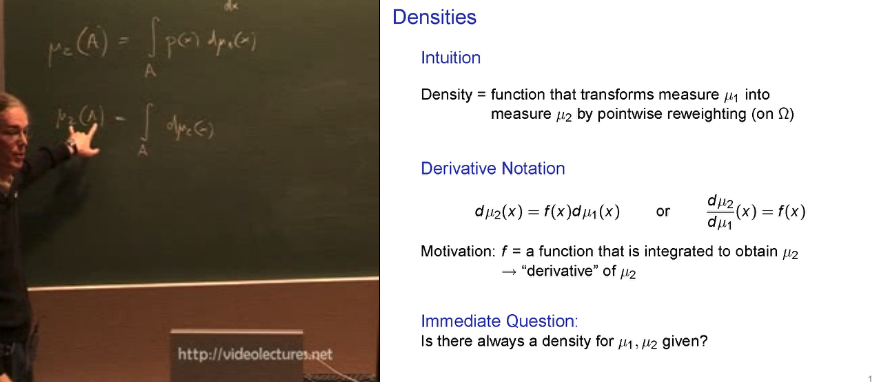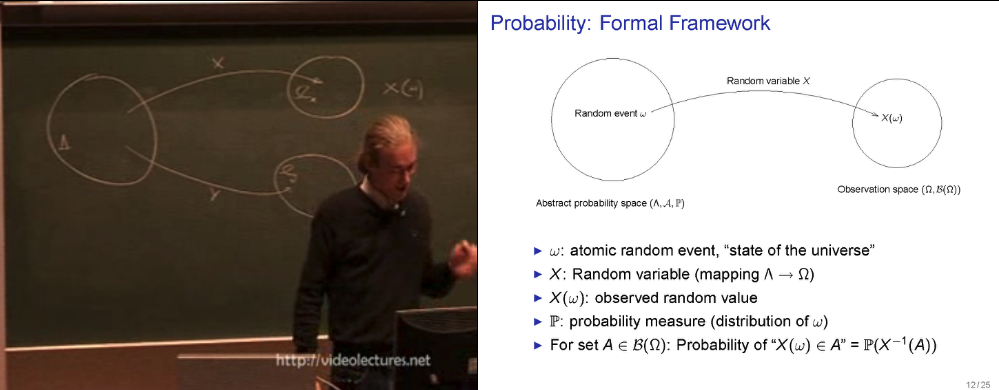Basic concepts in measure theory
Measure
 - Intuition: roughly a measure is an integral as a function of its region
- Intuition: roughly a measure is an integral as a function of its region
For example, in geometric case, \(\mu(A)\) can be interpreted as a (physical) length (if \(A\) is one dimensional), mass (if \(A\) is two dimensional), or volumn (if three-dim) of a region \(A\). In the case that \(\mu\) is a measure of probability, \(\mu(A)\) is the probability mass of event, "random variable \(X\) takes values in the set \(A\) (also called event \(A\))"
Density
 A (probability) density is a function that transforms one measure to another measure by pointwise reweighting (on the abstract sample space \(\Omega\))
A (probability) density is a function that transforms one measure to another measure by pointwise reweighting (on the abstract sample space \(\Omega\))

Measure-theoretic formalism for Probability

- abstract probability space vs. observation space Think of the abstract probability space as the entire system of the universe. A point in the space is a state of the universe (eg. a long vector of values assigned to all existing atoms' states). We often don't have a direct access to this "state", ie. it is not fully observable to us. Instead we observe/measure variables that are some functions of this atomic configuration/state (\(w\)). This mapping from a state of the universe to a value that the variable of our interest is observed/measured to take is called a "Random Variable".
Random Variable
 - is a function that maps a outcome in the abstract probability space's sample space \(\Lambda\) to the sample space of the observation space \(\Omega\) (often \(\mathbb{R}\))
- it is the key component that connects the abstract probability space (which we don't get to directly observe) to the observation space
- Image measure \(\mu_{X}\) is the (derived/induced) measure on the observation space that is related to the abstract probability space via the random variable \(X\).
- We need it since the measure on the abstract probability space \(\mathbb{P}\) is not known explicitly, but we need to have a way to descirbe the measure of sets in the Borel set of the observation space.
- To assign measures to an event in the observation space, we use "Image measure" \(\mu_{X}\) which is linked to \(\mathbb{P}\) via:
- is a function that maps a outcome in the abstract probability space's sample space \(\Lambda\) to the sample space of the observation space \(\Omega\) (often \(\mathbb{R}\))
- it is the key component that connects the abstract probability space (which we don't get to directly observe) to the observation space
- Image measure \(\mu_{X}\) is the (derived/induced) measure on the observation space that is related to the abstract probability space via the random variable \(X\).
- We need it since the measure on the abstract probability space \(\mathbb{P}\) is not known explicitly, but we need to have a way to descirbe the measure of sets in the Borel set of the observation space.
- To assign measures to an event in the observation space, we use "Image measure" \(\mu_{X}\) which is linked to \(\mathbb{P}\) via:
- In other words, we compute the probability measure of an event \(A\) (ie.the probability that the random variable X takes a value in the set A) by: 1. Map the set A in the observation space to a space in the abstract probability space, \(A^{\leftarrow} = X^{-1}(A)\) 2. Compute the probability of event \(A^{\leftarrow}\) using \(\mathbb{P}\)
Relationship between two random variables and their image measures
"Density" describes the relationship between two random variables and their image measures:
Source
- Theoretical Foundations of Nonparametric Bayesian Models, by P.Orbanz. MLSS2009: video part 1, 2. Slides 1, 2 Great introduction of measure theory just as much in detail to be relevant for statistics (and nonparametric Bayesian models)
More resources
- MLSS09 all lecture and slide links: here